The Developing Manager: Management, Leadership, and Career Development
VerifiedAdded on 2020/01/28
|15
|5103
|64
Report
AI Summary
This report delves into the multifaceted role of a developing manager, examining key aspects such as understanding managerial principles and behaviors, assessing managerial skills and potential, and exploring career development within an organizational context. The report analyzes various management styles, including directive and participative approaches, and discusses leadership characteristics, evaluating communication processes and organizational structures in companies like Nike and NHS. It also assesses the manager's role in leading and motivating teams to achieve organizational goals, justifying managerial decisions, and developing a career path within an organization. The report covers scientific management theories and cultural dimensions, including Hofstede's framework, and Handy's cultural models. Furthermore, the report includes self-assessments of managerial skills, strengths, weaknesses, opportunities, and threats, along with the prioritization of organizational objectives and targets. This comprehensive analysis provides insights into effective management practices and career development strategies.
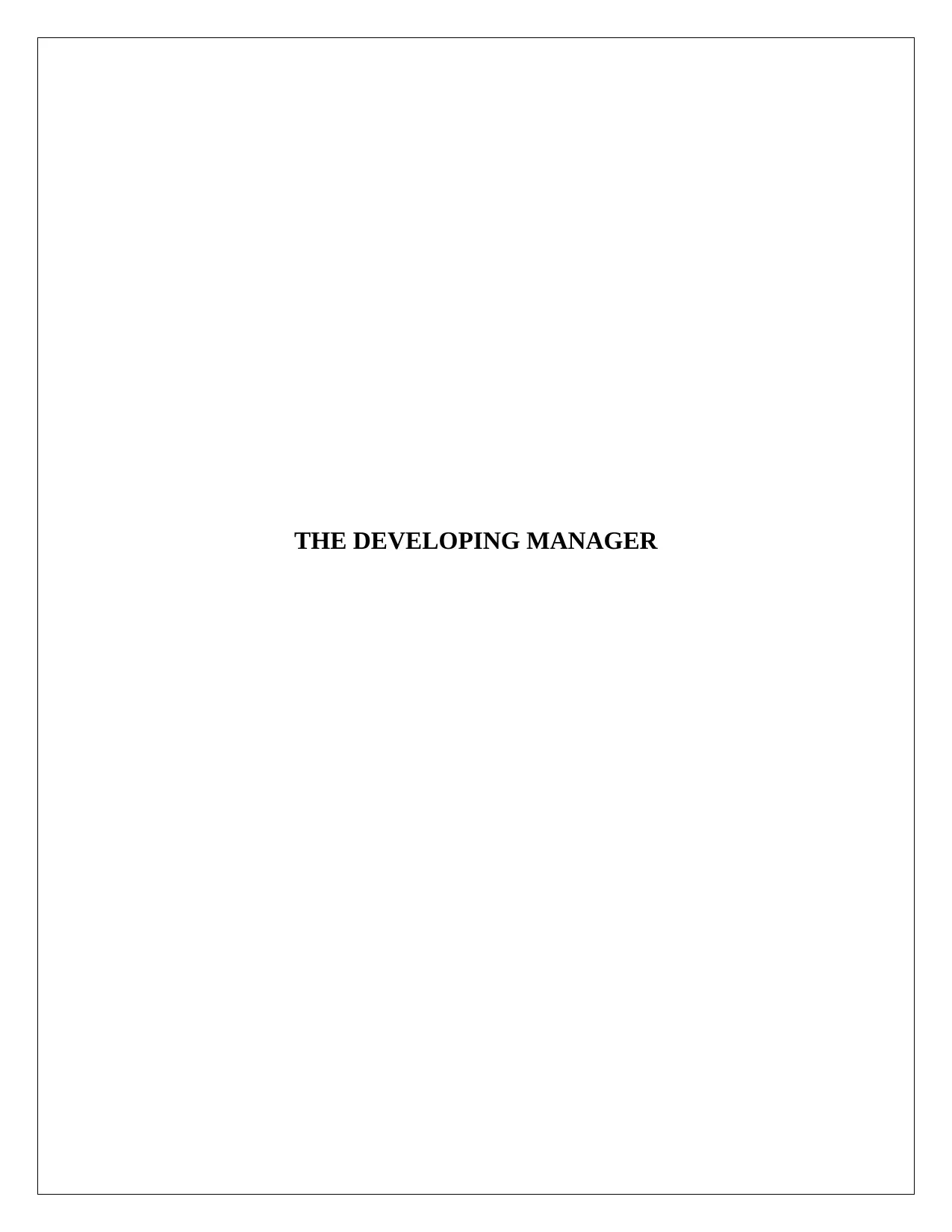
THE DEVELOPING MANAGER
Paraphrase This Document
Need a fresh take? Get an instant paraphrase of this document with our AI Paraphraser
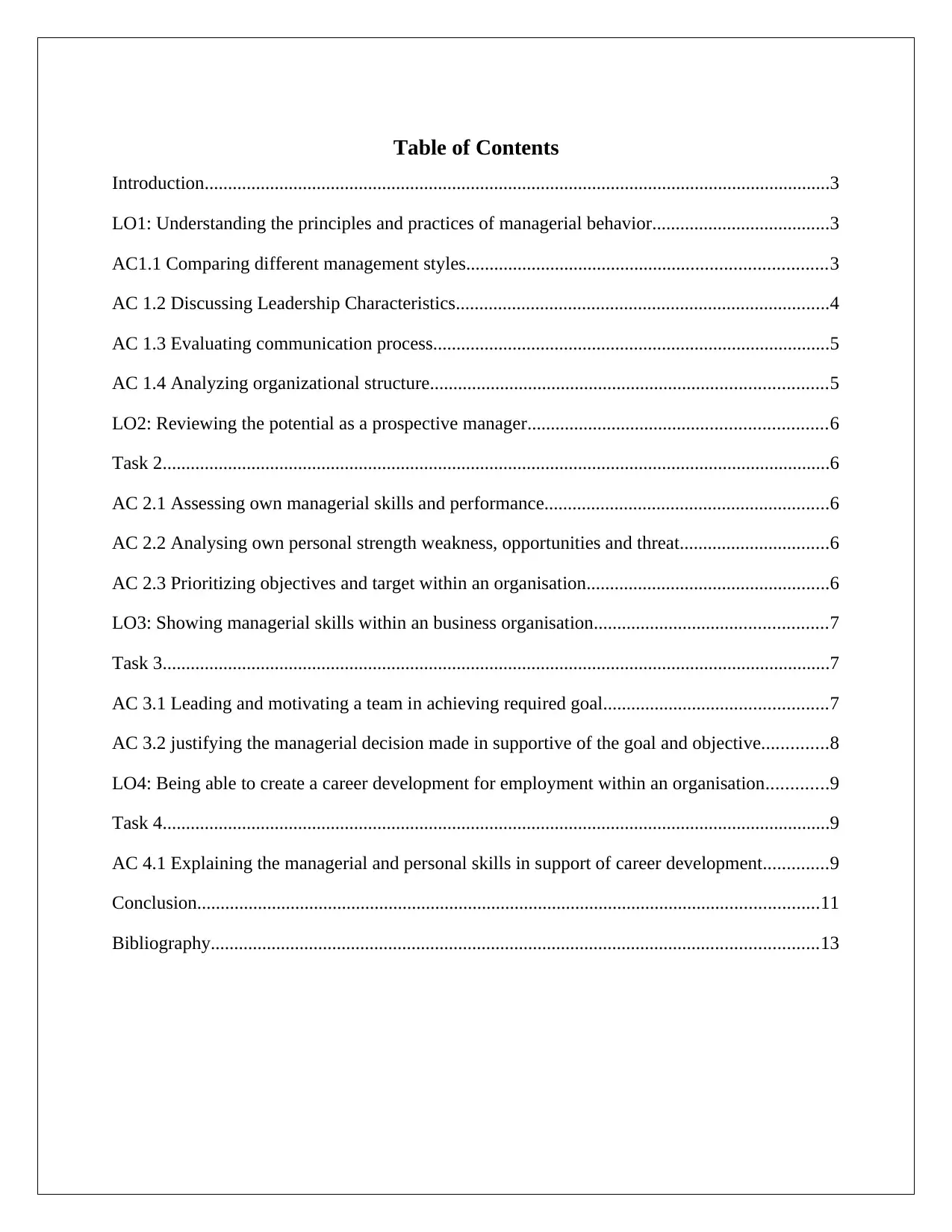
Table of Contents
Introduction......................................................................................................................................3
LO1: Understanding the principles and practices of managerial behavior......................................3
AC1.1 Comparing different management styles.............................................................................3
AC 1.2 Discussing Leadership Characteristics................................................................................4
AC 1.3 Evaluating communication process.....................................................................................5
AC 1.4 Analyzing organizational structure.....................................................................................5
LO2: Reviewing the potential as a prospective manager................................................................6
Task 2...............................................................................................................................................6
AC 2.1 Assessing own managerial skills and performance.............................................................6
AC 2.2 Analysing own personal strength weakness, opportunities and threat................................6
AC 2.3 Prioritizing objectives and target within an organisation....................................................6
LO3: Showing managerial skills within an business organisation..................................................7
Task 3...............................................................................................................................................7
AC 3.1 Leading and motivating a team in achieving required goal................................................7
AC 3.2 justifying the managerial decision made in supportive of the goal and objective..............8
LO4: Being able to create a career development for employment within an organisation.............9
Task 4...............................................................................................................................................9
AC 4.1 Explaining the managerial and personal skills in support of career development..............9
Conclusion.....................................................................................................................................11
Bibliography..................................................................................................................................13
Introduction......................................................................................................................................3
LO1: Understanding the principles and practices of managerial behavior......................................3
AC1.1 Comparing different management styles.............................................................................3
AC 1.2 Discussing Leadership Characteristics................................................................................4
AC 1.3 Evaluating communication process.....................................................................................5
AC 1.4 Analyzing organizational structure.....................................................................................5
LO2: Reviewing the potential as a prospective manager................................................................6
Task 2...............................................................................................................................................6
AC 2.1 Assessing own managerial skills and performance.............................................................6
AC 2.2 Analysing own personal strength weakness, opportunities and threat................................6
AC 2.3 Prioritizing objectives and target within an organisation....................................................6
LO3: Showing managerial skills within an business organisation..................................................7
Task 3...............................................................................................................................................7
AC 3.1 Leading and motivating a team in achieving required goal................................................7
AC 3.2 justifying the managerial decision made in supportive of the goal and objective..............8
LO4: Being able to create a career development for employment within an organisation.............9
Task 4...............................................................................................................................................9
AC 4.1 Explaining the managerial and personal skills in support of career development..............9
Conclusion.....................................................................................................................................11
Bibliography..................................................................................................................................13
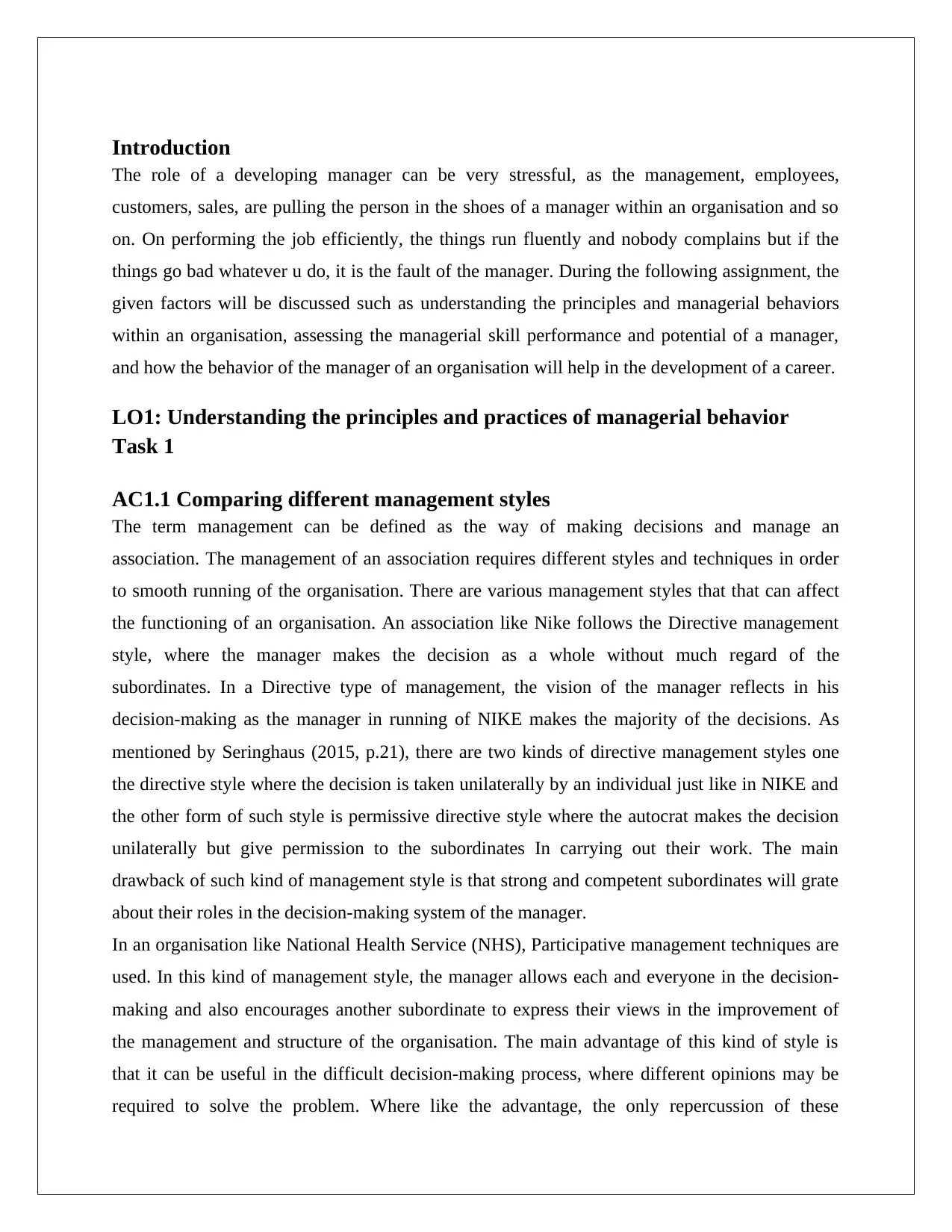
Introduction
The role of a developing manager can be very stressful, as the management, employees,
customers, sales, are pulling the person in the shoes of a manager within an organisation and so
on. On performing the job efficiently, the things run fluently and nobody complains but if the
things go bad whatever u do, it is the fault of the manager. During the following assignment, the
given factors will be discussed such as understanding the principles and managerial behaviors
within an organisation, assessing the managerial skill performance and potential of a manager,
and how the behavior of the manager of an organisation will help in the development of a career.
LO1: Understanding the principles and practices of managerial behavior
Task 1
AC1.1 Comparing different management styles
The term management can be defined as the way of making decisions and manage an
association. The management of an association requires different styles and techniques in order
to smooth running of the organisation. There are various management styles that that can affect
the functioning of an organisation. An association like Nike follows the Directive management
style, where the manager makes the decision as a whole without much regard of the
subordinates. In a Directive type of management, the vision of the manager reflects in his
decision-making as the manager in running of NIKE makes the majority of the decisions. As
mentioned by Seringhaus (2015, p.21), there are two kinds of directive management styles one
the directive style where the decision is taken unilaterally by an individual just like in NIKE and
the other form of such style is permissive directive style where the autocrat makes the decision
unilaterally but give permission to the subordinates In carrying out their work. The main
drawback of such kind of management style is that strong and competent subordinates will grate
about their roles in the decision-making system of the manager.
In an organisation like National Health Service (NHS), Participative management techniques are
used. In this kind of management style, the manager allows each and everyone in the decision-
making and also encourages another subordinate to express their views in the improvement of
the management and structure of the organisation. The main advantage of this kind of style is
that it can be useful in the difficult decision-making process, where different opinions may be
required to solve the problem. Where like the advantage, the only repercussion of these
The role of a developing manager can be very stressful, as the management, employees,
customers, sales, are pulling the person in the shoes of a manager within an organisation and so
on. On performing the job efficiently, the things run fluently and nobody complains but if the
things go bad whatever u do, it is the fault of the manager. During the following assignment, the
given factors will be discussed such as understanding the principles and managerial behaviors
within an organisation, assessing the managerial skill performance and potential of a manager,
and how the behavior of the manager of an organisation will help in the development of a career.
LO1: Understanding the principles and practices of managerial behavior
Task 1
AC1.1 Comparing different management styles
The term management can be defined as the way of making decisions and manage an
association. The management of an association requires different styles and techniques in order
to smooth running of the organisation. There are various management styles that that can affect
the functioning of an organisation. An association like Nike follows the Directive management
style, where the manager makes the decision as a whole without much regard of the
subordinates. In a Directive type of management, the vision of the manager reflects in his
decision-making as the manager in running of NIKE makes the majority of the decisions. As
mentioned by Seringhaus (2015, p.21), there are two kinds of directive management styles one
the directive style where the decision is taken unilaterally by an individual just like in NIKE and
the other form of such style is permissive directive style where the autocrat makes the decision
unilaterally but give permission to the subordinates In carrying out their work. The main
drawback of such kind of management style is that strong and competent subordinates will grate
about their roles in the decision-making system of the manager.
In an organisation like National Health Service (NHS), Participative management techniques are
used. In this kind of management style, the manager allows each and everyone in the decision-
making and also encourages another subordinate to express their views in the improvement of
the management and structure of the organisation. The main advantage of this kind of style is
that it can be useful in the difficult decision-making process, where different opinions may be
required to solve the problem. Where like the advantage, the only repercussion of these
⊘ This is a preview!⊘
Do you want full access?
Subscribe today to unlock all pages.

Trusted by 1+ million students worldwide
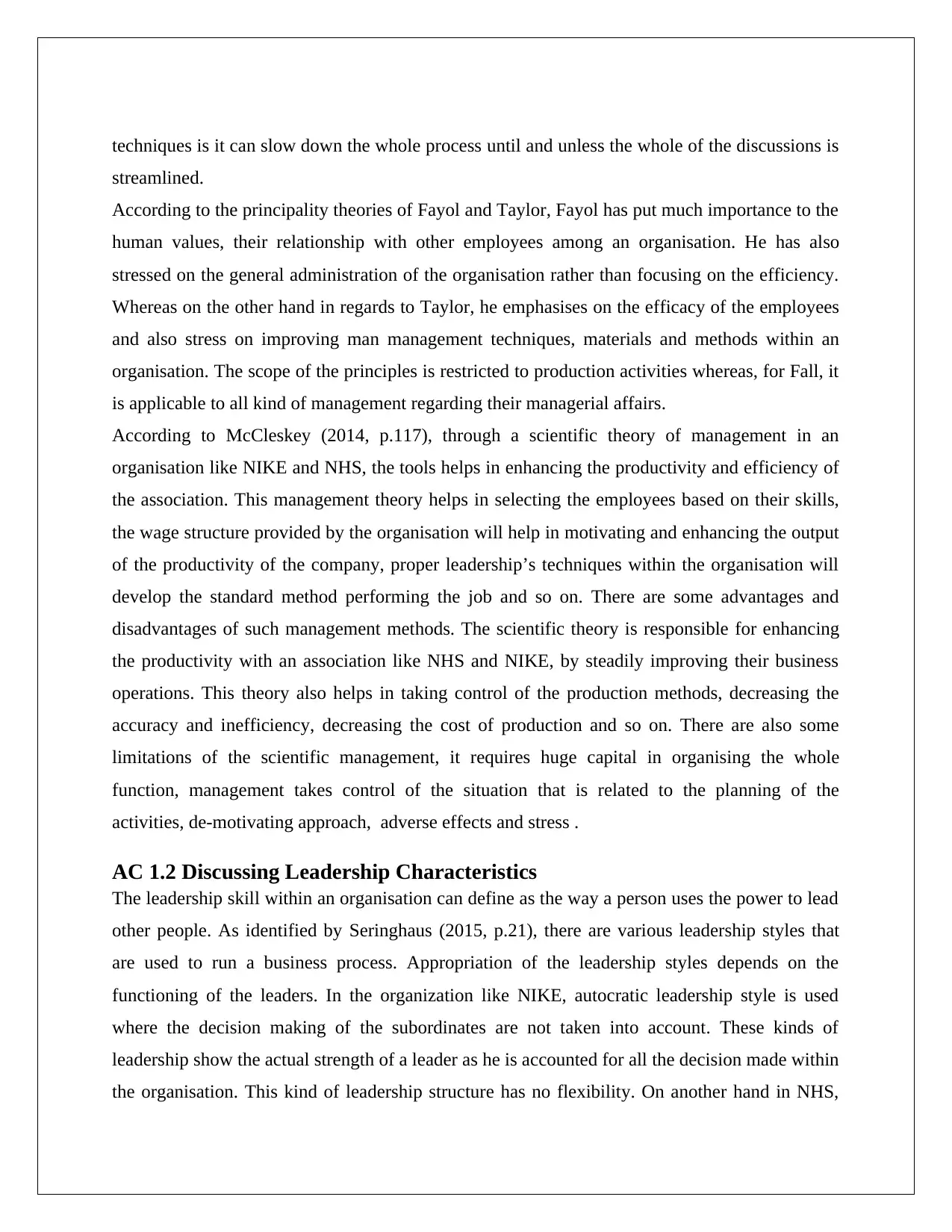
techniques is it can slow down the whole process until and unless the whole of the discussions is
streamlined.
According to the principality theories of Fayol and Taylor, Fayol has put much importance to the
human values, their relationship with other employees among an organisation. He has also
stressed on the general administration of the organisation rather than focusing on the efficiency.
Whereas on the other hand in regards to Taylor, he emphasises on the efficacy of the employees
and also stress on improving man management techniques, materials and methods within an
organisation. The scope of the principles is restricted to production activities whereas, for Fall, it
is applicable to all kind of management regarding their managerial affairs.
According to McCleskey (2014, p.117), through a scientific theory of management in an
organisation like NIKE and NHS, the tools helps in enhancing the productivity and efficiency of
the association. This management theory helps in selecting the employees based on their skills,
the wage structure provided by the organisation will help in motivating and enhancing the output
of the productivity of the company, proper leadership’s techniques within the organisation will
develop the standard method performing the job and so on. There are some advantages and
disadvantages of such management methods. The scientific theory is responsible for enhancing
the productivity with an association like NHS and NIKE, by steadily improving their business
operations. This theory also helps in taking control of the production methods, decreasing the
accuracy and inefficiency, decreasing the cost of production and so on. There are also some
limitations of the scientific management, it requires huge capital in organising the whole
function, management takes control of the situation that is related to the planning of the
activities, de-motivating approach, adverse effects and stress .
AC 1.2 Discussing Leadership Characteristics
The leadership skill within an organisation can define as the way a person uses the power to lead
other people. As identified by Seringhaus (2015, p.21), there are various leadership styles that
are used to run a business process. Appropriation of the leadership styles depends on the
functioning of the leaders. In the organization like NIKE, autocratic leadership style is used
where the decision making of the subordinates are not taken into account. These kinds of
leadership show the actual strength of a leader as he is accounted for all the decision made within
the organisation. This kind of leadership structure has no flexibility. On another hand in NHS,
streamlined.
According to the principality theories of Fayol and Taylor, Fayol has put much importance to the
human values, their relationship with other employees among an organisation. He has also
stressed on the general administration of the organisation rather than focusing on the efficiency.
Whereas on the other hand in regards to Taylor, he emphasises on the efficacy of the employees
and also stress on improving man management techniques, materials and methods within an
organisation. The scope of the principles is restricted to production activities whereas, for Fall, it
is applicable to all kind of management regarding their managerial affairs.
According to McCleskey (2014, p.117), through a scientific theory of management in an
organisation like NIKE and NHS, the tools helps in enhancing the productivity and efficiency of
the association. This management theory helps in selecting the employees based on their skills,
the wage structure provided by the organisation will help in motivating and enhancing the output
of the productivity of the company, proper leadership’s techniques within the organisation will
develop the standard method performing the job and so on. There are some advantages and
disadvantages of such management methods. The scientific theory is responsible for enhancing
the productivity with an association like NHS and NIKE, by steadily improving their business
operations. This theory also helps in taking control of the production methods, decreasing the
accuracy and inefficiency, decreasing the cost of production and so on. There are also some
limitations of the scientific management, it requires huge capital in organising the whole
function, management takes control of the situation that is related to the planning of the
activities, de-motivating approach, adverse effects and stress .
AC 1.2 Discussing Leadership Characteristics
The leadership skill within an organisation can define as the way a person uses the power to lead
other people. As identified by Seringhaus (2015, p.21), there are various leadership styles that
are used to run a business process. Appropriation of the leadership styles depends on the
functioning of the leaders. In the organization like NIKE, autocratic leadership style is used
where the decision making of the subordinates are not taken into account. These kinds of
leadership show the actual strength of a leader as he is accounted for all the decision made within
the organisation. This kind of leadership structure has no flexibility. On another hand in NHS,
Paraphrase This Document
Need a fresh take? Get an instant paraphrase of this document with our AI Paraphraser
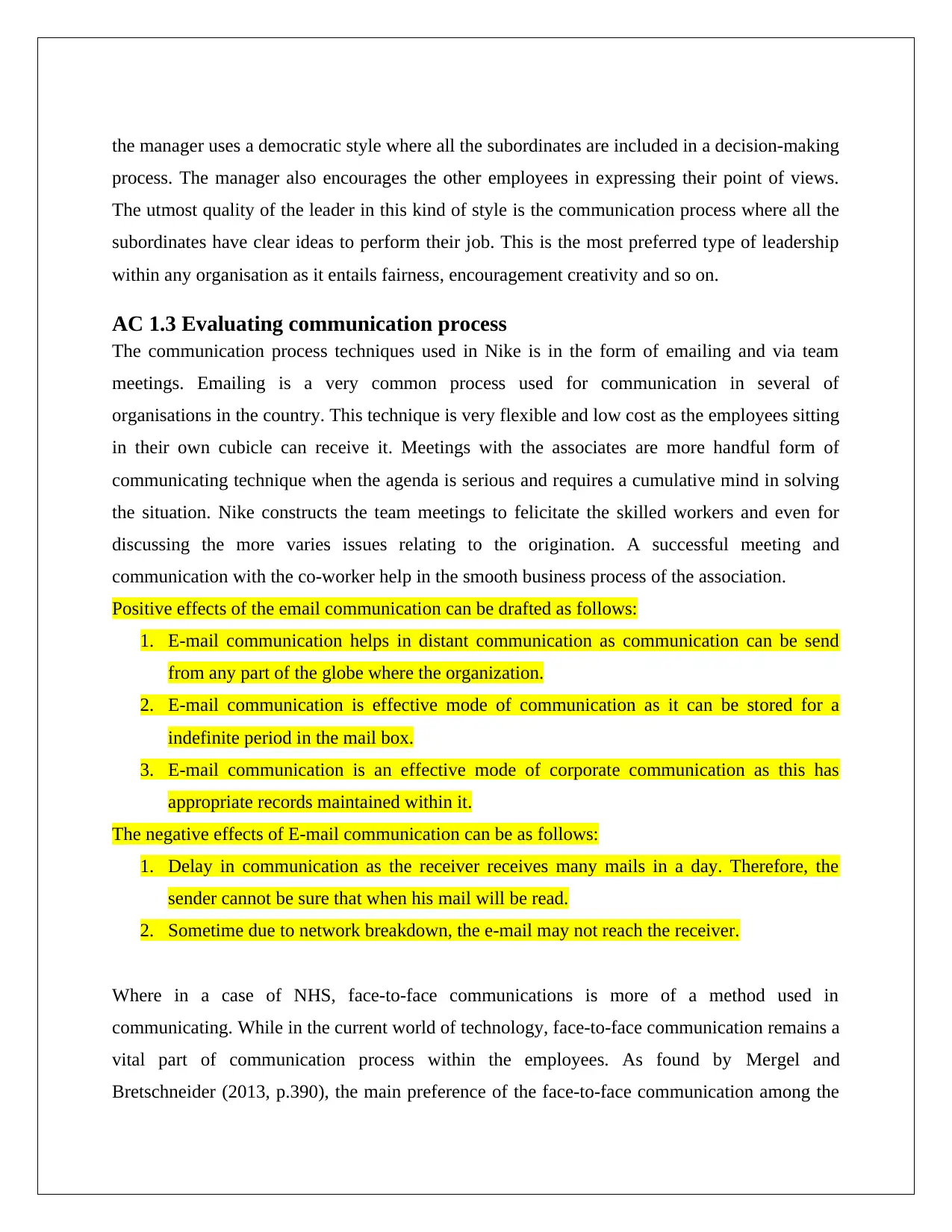
the manager uses a democratic style where all the subordinates are included in a decision-making
process. The manager also encourages the other employees in expressing their point of views.
The utmost quality of the leader in this kind of style is the communication process where all the
subordinates have clear ideas to perform their job. This is the most preferred type of leadership
within any organisation as it entails fairness, encouragement creativity and so on.
AC 1.3 Evaluating communication process
The communication process techniques used in Nike is in the form of emailing and via team
meetings. Emailing is a very common process used for communication in several of
organisations in the country. This technique is very flexible and low cost as the employees sitting
in their own cubicle can receive it. Meetings with the associates are more handful form of
communicating technique when the agenda is serious and requires a cumulative mind in solving
the situation. Nike constructs the team meetings to felicitate the skilled workers and even for
discussing the more varies issues relating to the origination. A successful meeting and
communication with the co-worker help in the smooth business process of the association.
Positive effects of the email communication can be drafted as follows:
1. E-mail communication helps in distant communication as communication can be send
from any part of the globe where the organization.
2. E-mail communication is effective mode of communication as it can be stored for a
indefinite period in the mail box.
3. E-mail communication is an effective mode of corporate communication as this has
appropriate records maintained within it.
The negative effects of E-mail communication can be as follows:
1. Delay in communication as the receiver receives many mails in a day. Therefore, the
sender cannot be sure that when his mail will be read.
2. Sometime due to network breakdown, the e-mail may not reach the receiver.
Where in a case of NHS, face-to-face communications is more of a method used in
communicating. While in the current world of technology, face-to-face communication remains a
vital part of communication process within the employees. As found by Mergel and
Bretschneider (2013, p.390), the main preference of the face-to-face communication among the
process. The manager also encourages the other employees in expressing their point of views.
The utmost quality of the leader in this kind of style is the communication process where all the
subordinates have clear ideas to perform their job. This is the most preferred type of leadership
within any organisation as it entails fairness, encouragement creativity and so on.
AC 1.3 Evaluating communication process
The communication process techniques used in Nike is in the form of emailing and via team
meetings. Emailing is a very common process used for communication in several of
organisations in the country. This technique is very flexible and low cost as the employees sitting
in their own cubicle can receive it. Meetings with the associates are more handful form of
communicating technique when the agenda is serious and requires a cumulative mind in solving
the situation. Nike constructs the team meetings to felicitate the skilled workers and even for
discussing the more varies issues relating to the origination. A successful meeting and
communication with the co-worker help in the smooth business process of the association.
Positive effects of the email communication can be drafted as follows:
1. E-mail communication helps in distant communication as communication can be send
from any part of the globe where the organization.
2. E-mail communication is effective mode of communication as it can be stored for a
indefinite period in the mail box.
3. E-mail communication is an effective mode of corporate communication as this has
appropriate records maintained within it.
The negative effects of E-mail communication can be as follows:
1. Delay in communication as the receiver receives many mails in a day. Therefore, the
sender cannot be sure that when his mail will be read.
2. Sometime due to network breakdown, the e-mail may not reach the receiver.
Where in a case of NHS, face-to-face communications is more of a method used in
communicating. While in the current world of technology, face-to-face communication remains a
vital part of communication process within the employees. As found by Mergel and
Bretschneider (2013, p.390), the main preference of the face-to-face communication among the
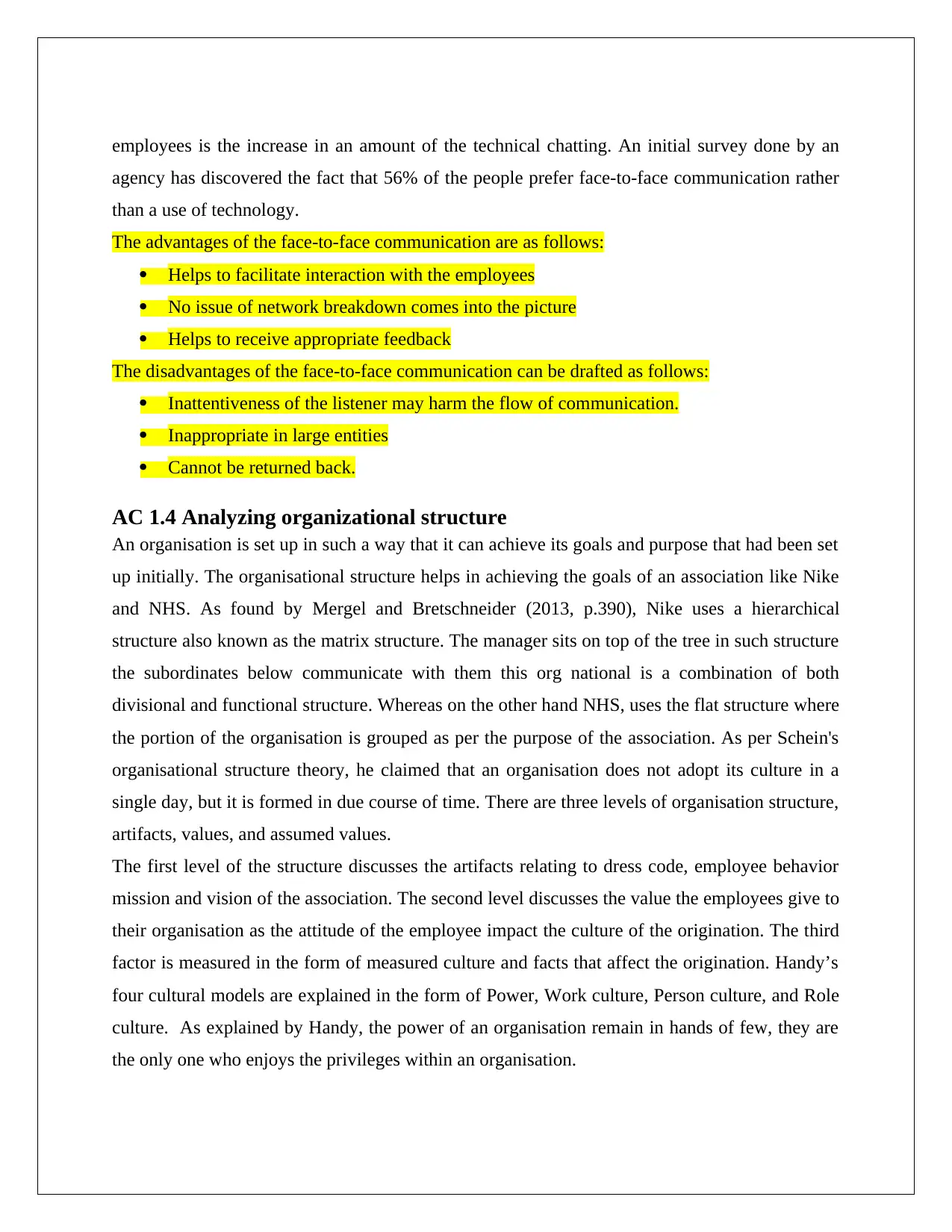
employees is the increase in an amount of the technical chatting. An initial survey done by an
agency has discovered the fact that 56% of the people prefer face-to-face communication rather
than a use of technology.
The advantages of the face-to-face communication are as follows:
Helps to facilitate interaction with the employees
No issue of network breakdown comes into the picture
Helps to receive appropriate feedback
The disadvantages of the face-to-face communication can be drafted as follows:
Inattentiveness of the listener may harm the flow of communication.
Inappropriate in large entities
Cannot be returned back.
AC 1.4 Analyzing organizational structure
An organisation is set up in such a way that it can achieve its goals and purpose that had been set
up initially. The organisational structure helps in achieving the goals of an association like Nike
and NHS. As found by Mergel and Bretschneider (2013, p.390), Nike uses a hierarchical
structure also known as the matrix structure. The manager sits on top of the tree in such structure
the subordinates below communicate with them this org national is a combination of both
divisional and functional structure. Whereas on the other hand NHS, uses the flat structure where
the portion of the organisation is grouped as per the purpose of the association. As per Schein's
organisational structure theory, he claimed that an organisation does not adopt its culture in a
single day, but it is formed in due course of time. There are three levels of organisation structure,
artifacts, values, and assumed values.
The first level of the structure discusses the artifacts relating to dress code, employee behavior
mission and vision of the association. The second level discusses the value the employees give to
their organisation as the attitude of the employee impact the culture of the origination. The third
factor is measured in the form of measured culture and facts that affect the origination. Handy’s
four cultural models are explained in the form of Power, Work culture, Person culture, and Role
culture. As explained by Handy, the power of an organisation remain in hands of few, they are
the only one who enjoys the privileges within an organisation.
agency has discovered the fact that 56% of the people prefer face-to-face communication rather
than a use of technology.
The advantages of the face-to-face communication are as follows:
Helps to facilitate interaction with the employees
No issue of network breakdown comes into the picture
Helps to receive appropriate feedback
The disadvantages of the face-to-face communication can be drafted as follows:
Inattentiveness of the listener may harm the flow of communication.
Inappropriate in large entities
Cannot be returned back.
AC 1.4 Analyzing organizational structure
An organisation is set up in such a way that it can achieve its goals and purpose that had been set
up initially. The organisational structure helps in achieving the goals of an association like Nike
and NHS. As found by Mergel and Bretschneider (2013, p.390), Nike uses a hierarchical
structure also known as the matrix structure. The manager sits on top of the tree in such structure
the subordinates below communicate with them this org national is a combination of both
divisional and functional structure. Whereas on the other hand NHS, uses the flat structure where
the portion of the organisation is grouped as per the purpose of the association. As per Schein's
organisational structure theory, he claimed that an organisation does not adopt its culture in a
single day, but it is formed in due course of time. There are three levels of organisation structure,
artifacts, values, and assumed values.
The first level of the structure discusses the artifacts relating to dress code, employee behavior
mission and vision of the association. The second level discusses the value the employees give to
their organisation as the attitude of the employee impact the culture of the origination. The third
factor is measured in the form of measured culture and facts that affect the origination. Handy’s
four cultural models are explained in the form of Power, Work culture, Person culture, and Role
culture. As explained by Handy, the power of an organisation remain in hands of few, they are
the only one who enjoys the privileges within an organisation.
⊘ This is a preview!⊘
Do you want full access?
Subscribe today to unlock all pages.

Trusted by 1+ million students worldwide
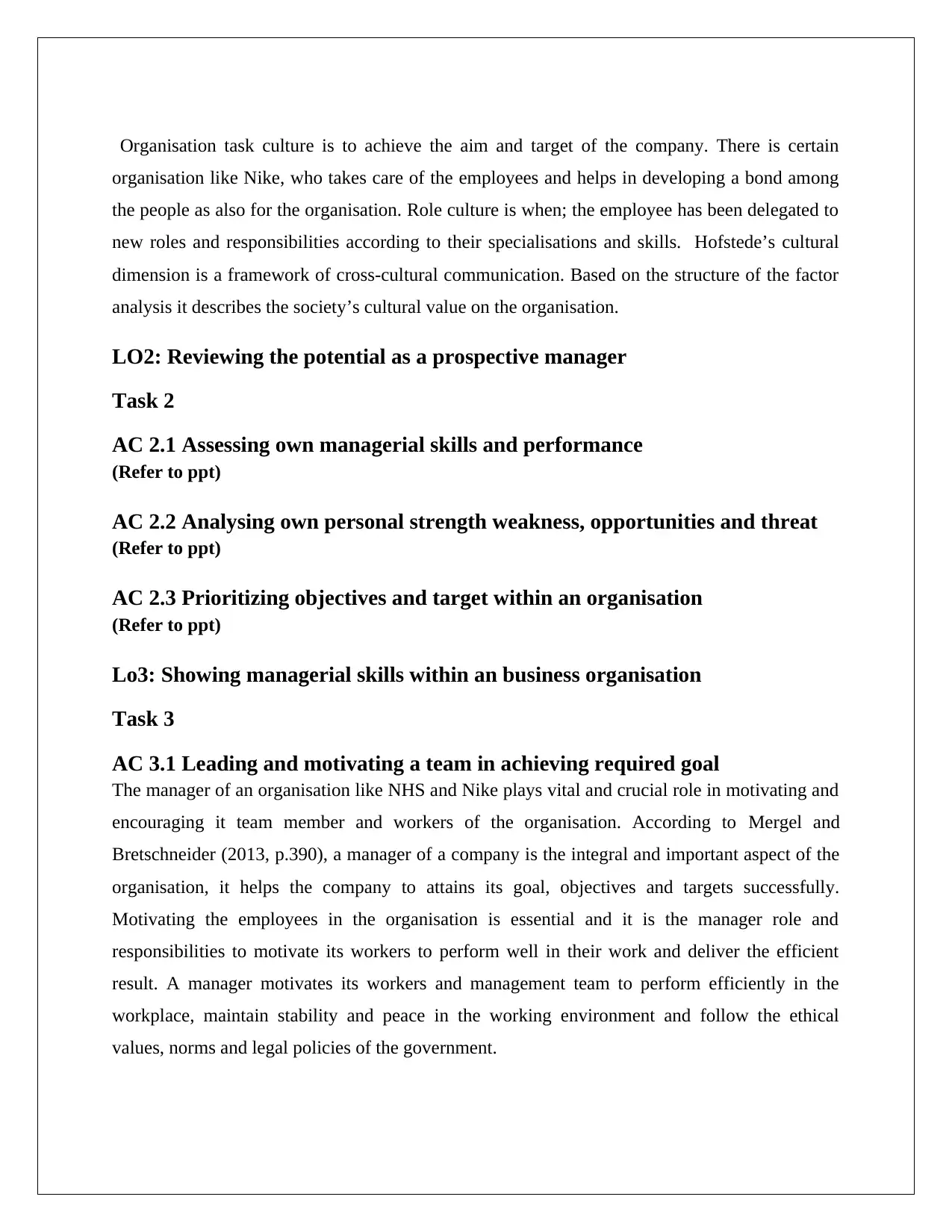
Organisation task culture is to achieve the aim and target of the company. There is certain
organisation like Nike, who takes care of the employees and helps in developing a bond among
the people as also for the organisation. Role culture is when; the employee has been delegated to
new roles and responsibilities according to their specialisations and skills. Hofstede’s cultural
dimension is a framework of cross-cultural communication. Based on the structure of the factor
analysis it describes the society’s cultural value on the organisation.
LO2: Reviewing the potential as a prospective manager
Task 2
AC 2.1 Assessing own managerial skills and performance
(Refer to ppt)
AC 2.2 Analysing own personal strength weakness, opportunities and threat
(Refer to ppt)
AC 2.3 Prioritizing objectives and target within an organisation
(Refer to ppt)
Lo3: Showing managerial skills within an business organisation
Task 3
AC 3.1 Leading and motivating a team in achieving required goal
The manager of an organisation like NHS and Nike plays vital and crucial role in motivating and
encouraging it team member and workers of the organisation. According to Mergel and
Bretschneider (2013, p.390), a manager of a company is the integral and important aspect of the
organisation, it helps the company to attains its goal, objectives and targets successfully.
Motivating the employees in the organisation is essential and it is the manager role and
responsibilities to motivate its workers to perform well in their work and deliver the efficient
result. A manager motivates its workers and management team to perform efficiently in the
workplace, maintain stability and peace in the working environment and follow the ethical
values, norms and legal policies of the government.
organisation like Nike, who takes care of the employees and helps in developing a bond among
the people as also for the organisation. Role culture is when; the employee has been delegated to
new roles and responsibilities according to their specialisations and skills. Hofstede’s cultural
dimension is a framework of cross-cultural communication. Based on the structure of the factor
analysis it describes the society’s cultural value on the organisation.
LO2: Reviewing the potential as a prospective manager
Task 2
AC 2.1 Assessing own managerial skills and performance
(Refer to ppt)
AC 2.2 Analysing own personal strength weakness, opportunities and threat
(Refer to ppt)
AC 2.3 Prioritizing objectives and target within an organisation
(Refer to ppt)
Lo3: Showing managerial skills within an business organisation
Task 3
AC 3.1 Leading and motivating a team in achieving required goal
The manager of an organisation like NHS and Nike plays vital and crucial role in motivating and
encouraging it team member and workers of the organisation. According to Mergel and
Bretschneider (2013, p.390), a manager of a company is the integral and important aspect of the
organisation, it helps the company to attains its goal, objectives and targets successfully.
Motivating the employees in the organisation is essential and it is the manager role and
responsibilities to motivate its workers to perform well in their work and deliver the efficient
result. A manager motivates its workers and management team to perform efficiently in the
workplace, maintain stability and peace in the working environment and follow the ethical
values, norms and legal policies of the government.
Paraphrase This Document
Need a fresh take? Get an instant paraphrase of this document with our AI Paraphraser
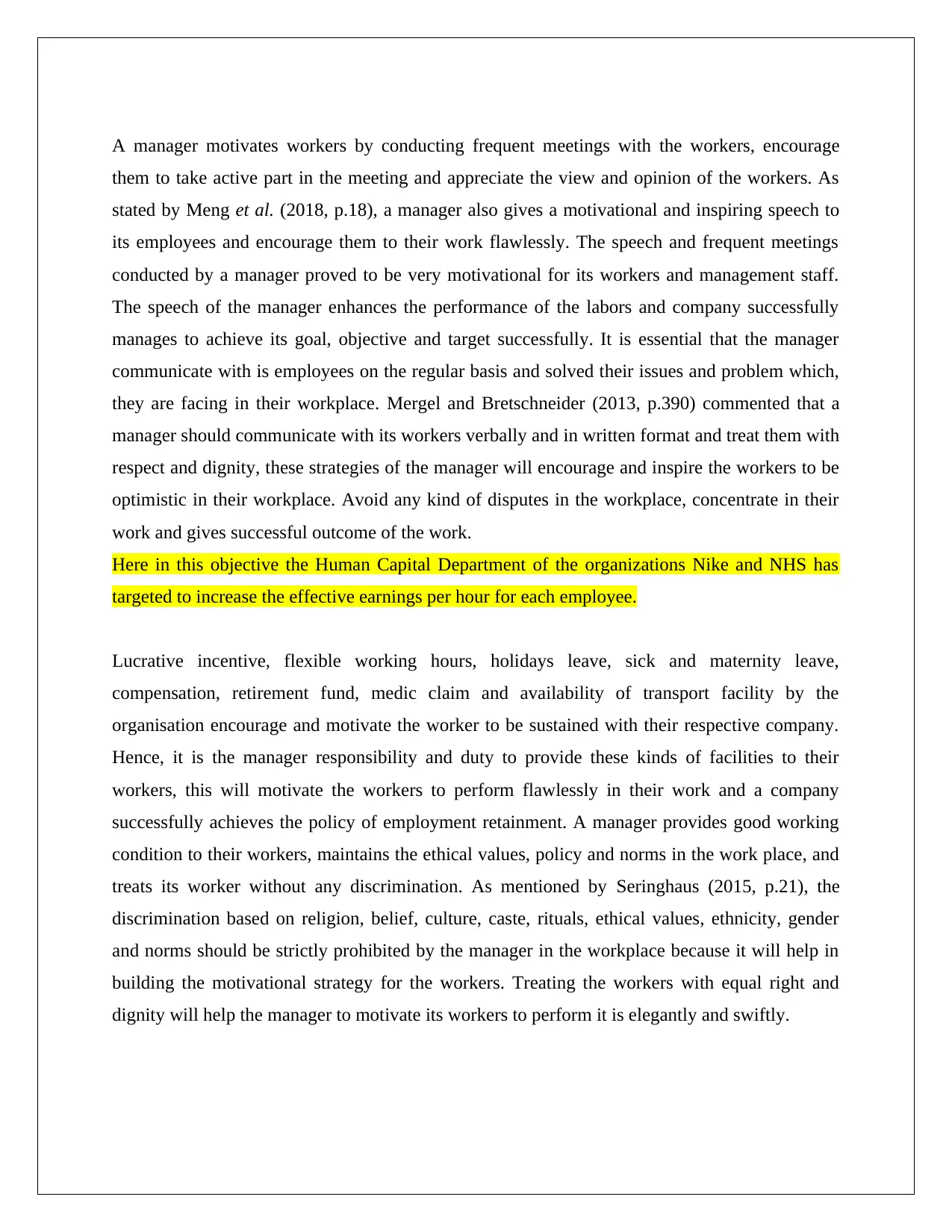
A manager motivates workers by conducting frequent meetings with the workers, encourage
them to take active part in the meeting and appreciate the view and opinion of the workers. As
stated by Meng et al. (2018, p.18), a manager also gives a motivational and inspiring speech to
its employees and encourage them to their work flawlessly. The speech and frequent meetings
conducted by a manager proved to be very motivational for its workers and management staff.
The speech of the manager enhances the performance of the labors and company successfully
manages to achieve its goal, objective and target successfully. It is essential that the manager
communicate with is employees on the regular basis and solved their issues and problem which,
they are facing in their workplace. Mergel and Bretschneider (2013, p.390) commented that a
manager should communicate with its workers verbally and in written format and treat them with
respect and dignity, these strategies of the manager will encourage and inspire the workers to be
optimistic in their workplace. Avoid any kind of disputes in the workplace, concentrate in their
work and gives successful outcome of the work.
Here in this objective the Human Capital Department of the organizations Nike and NHS has
targeted to increase the effective earnings per hour for each employee.
Lucrative incentive, flexible working hours, holidays leave, sick and maternity leave,
compensation, retirement fund, medic claim and availability of transport facility by the
organisation encourage and motivate the worker to be sustained with their respective company.
Hence, it is the manager responsibility and duty to provide these kinds of facilities to their
workers, this will motivate the workers to perform flawlessly in their work and a company
successfully achieves the policy of employment retainment. A manager provides good working
condition to their workers, maintains the ethical values, policy and norms in the work place, and
treats its worker without any discrimination. As mentioned by Seringhaus (2015, p.21), the
discrimination based on religion, belief, culture, caste, rituals, ethical values, ethnicity, gender
and norms should be strictly prohibited by the manager in the workplace because it will help in
building the motivational strategy for the workers. Treating the workers with equal right and
dignity will help the manager to motivate its workers to perform it is elegantly and swiftly.
them to take active part in the meeting and appreciate the view and opinion of the workers. As
stated by Meng et al. (2018, p.18), a manager also gives a motivational and inspiring speech to
its employees and encourage them to their work flawlessly. The speech and frequent meetings
conducted by a manager proved to be very motivational for its workers and management staff.
The speech of the manager enhances the performance of the labors and company successfully
manages to achieve its goal, objective and target successfully. It is essential that the manager
communicate with is employees on the regular basis and solved their issues and problem which,
they are facing in their workplace. Mergel and Bretschneider (2013, p.390) commented that a
manager should communicate with its workers verbally and in written format and treat them with
respect and dignity, these strategies of the manager will encourage and inspire the workers to be
optimistic in their workplace. Avoid any kind of disputes in the workplace, concentrate in their
work and gives successful outcome of the work.
Here in this objective the Human Capital Department of the organizations Nike and NHS has
targeted to increase the effective earnings per hour for each employee.
Lucrative incentive, flexible working hours, holidays leave, sick and maternity leave,
compensation, retirement fund, medic claim and availability of transport facility by the
organisation encourage and motivate the worker to be sustained with their respective company.
Hence, it is the manager responsibility and duty to provide these kinds of facilities to their
workers, this will motivate the workers to perform flawlessly in their work and a company
successfully achieves the policy of employment retainment. A manager provides good working
condition to their workers, maintains the ethical values, policy and norms in the work place, and
treats its worker without any discrimination. As mentioned by Seringhaus (2015, p.21), the
discrimination based on religion, belief, culture, caste, rituals, ethical values, ethnicity, gender
and norms should be strictly prohibited by the manager in the workplace because it will help in
building the motivational strategy for the workers. Treating the workers with equal right and
dignity will help the manager to motivate its workers to perform it is elegantly and swiftly.
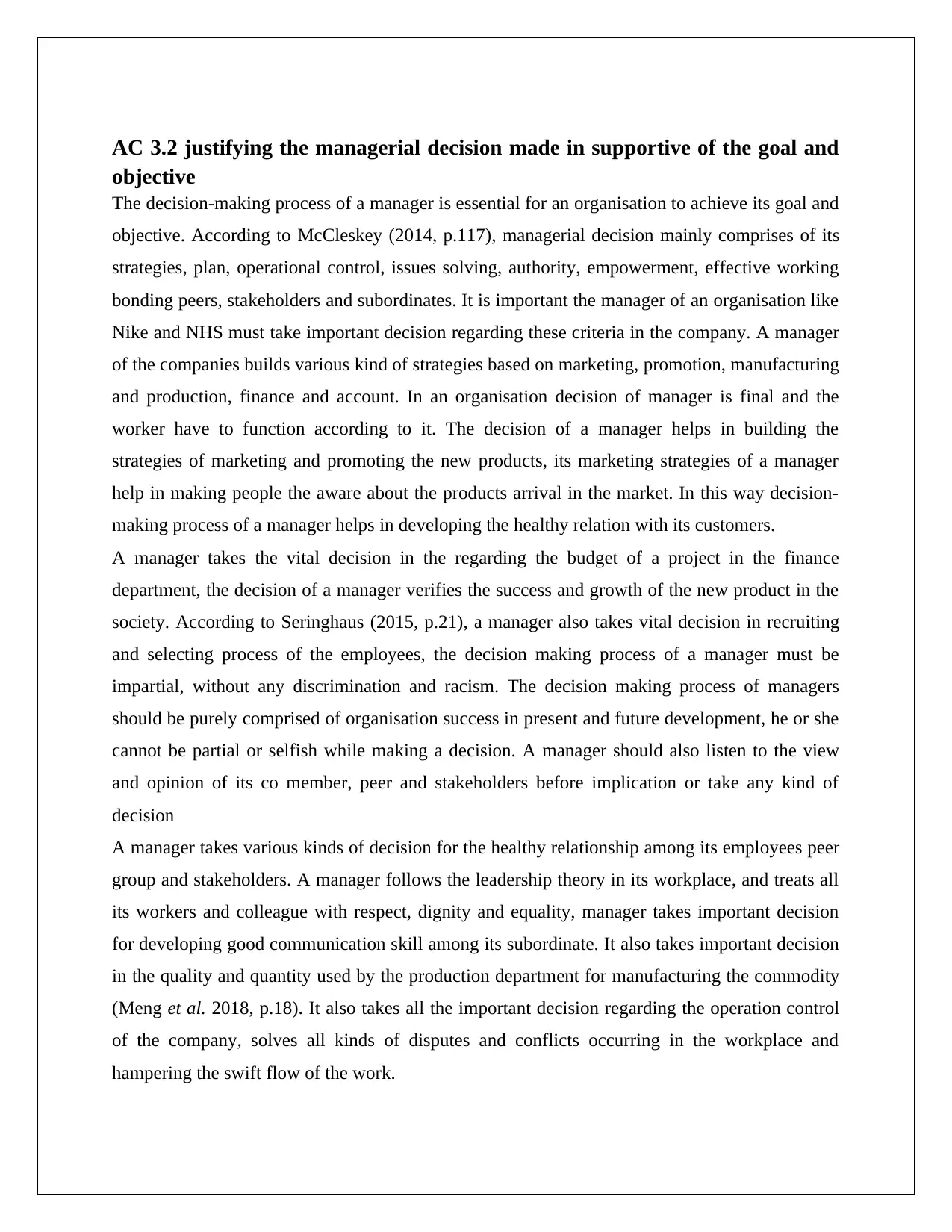
AC 3.2 justifying the managerial decision made in supportive of the goal and
objective
The decision-making process of a manager is essential for an organisation to achieve its goal and
objective. According to McCleskey (2014, p.117), managerial decision mainly comprises of its
strategies, plan, operational control, issues solving, authority, empowerment, effective working
bonding peers, stakeholders and subordinates. It is important the manager of an organisation like
Nike and NHS must take important decision regarding these criteria in the company. A manager
of the companies builds various kind of strategies based on marketing, promotion, manufacturing
and production, finance and account. In an organisation decision of manager is final and the
worker have to function according to it. The decision of a manager helps in building the
strategies of marketing and promoting the new products, its marketing strategies of a manager
help in making people the aware about the products arrival in the market. In this way decision-
making process of a manager helps in developing the healthy relation with its customers.
A manager takes the vital decision in the regarding the budget of a project in the finance
department, the decision of a manager verifies the success and growth of the new product in the
society. According to Seringhaus (2015, p.21), a manager also takes vital decision in recruiting
and selecting process of the employees, the decision making process of a manager must be
impartial, without any discrimination and racism. The decision making process of managers
should be purely comprised of organisation success in present and future development, he or she
cannot be partial or selfish while making a decision. A manager should also listen to the view
and opinion of its co member, peer and stakeholders before implication or take any kind of
decision
A manager takes various kinds of decision for the healthy relationship among its employees peer
group and stakeholders. A manager follows the leadership theory in its workplace, and treats all
its workers and colleague with respect, dignity and equality, manager takes important decision
for developing good communication skill among its subordinate. It also takes important decision
in the quality and quantity used by the production department for manufacturing the commodity
(Meng et al. 2018, p.18). It also takes all the important decision regarding the operation control
of the company, solves all kinds of disputes and conflicts occurring in the workplace and
hampering the swift flow of the work.
objective
The decision-making process of a manager is essential for an organisation to achieve its goal and
objective. According to McCleskey (2014, p.117), managerial decision mainly comprises of its
strategies, plan, operational control, issues solving, authority, empowerment, effective working
bonding peers, stakeholders and subordinates. It is important the manager of an organisation like
Nike and NHS must take important decision regarding these criteria in the company. A manager
of the companies builds various kind of strategies based on marketing, promotion, manufacturing
and production, finance and account. In an organisation decision of manager is final and the
worker have to function according to it. The decision of a manager helps in building the
strategies of marketing and promoting the new products, its marketing strategies of a manager
help in making people the aware about the products arrival in the market. In this way decision-
making process of a manager helps in developing the healthy relation with its customers.
A manager takes the vital decision in the regarding the budget of a project in the finance
department, the decision of a manager verifies the success and growth of the new product in the
society. According to Seringhaus (2015, p.21), a manager also takes vital decision in recruiting
and selecting process of the employees, the decision making process of a manager must be
impartial, without any discrimination and racism. The decision making process of managers
should be purely comprised of organisation success in present and future development, he or she
cannot be partial or selfish while making a decision. A manager should also listen to the view
and opinion of its co member, peer and stakeholders before implication or take any kind of
decision
A manager takes various kinds of decision for the healthy relationship among its employees peer
group and stakeholders. A manager follows the leadership theory in its workplace, and treats all
its workers and colleague with respect, dignity and equality, manager takes important decision
for developing good communication skill among its subordinate. It also takes important decision
in the quality and quantity used by the production department for manufacturing the commodity
(Meng et al. 2018, p.18). It also takes all the important decision regarding the operation control
of the company, solves all kinds of disputes and conflicts occurring in the workplace and
hampering the swift flow of the work.
⊘ This is a preview!⊘
Do you want full access?
Subscribe today to unlock all pages.

Trusted by 1+ million students worldwide
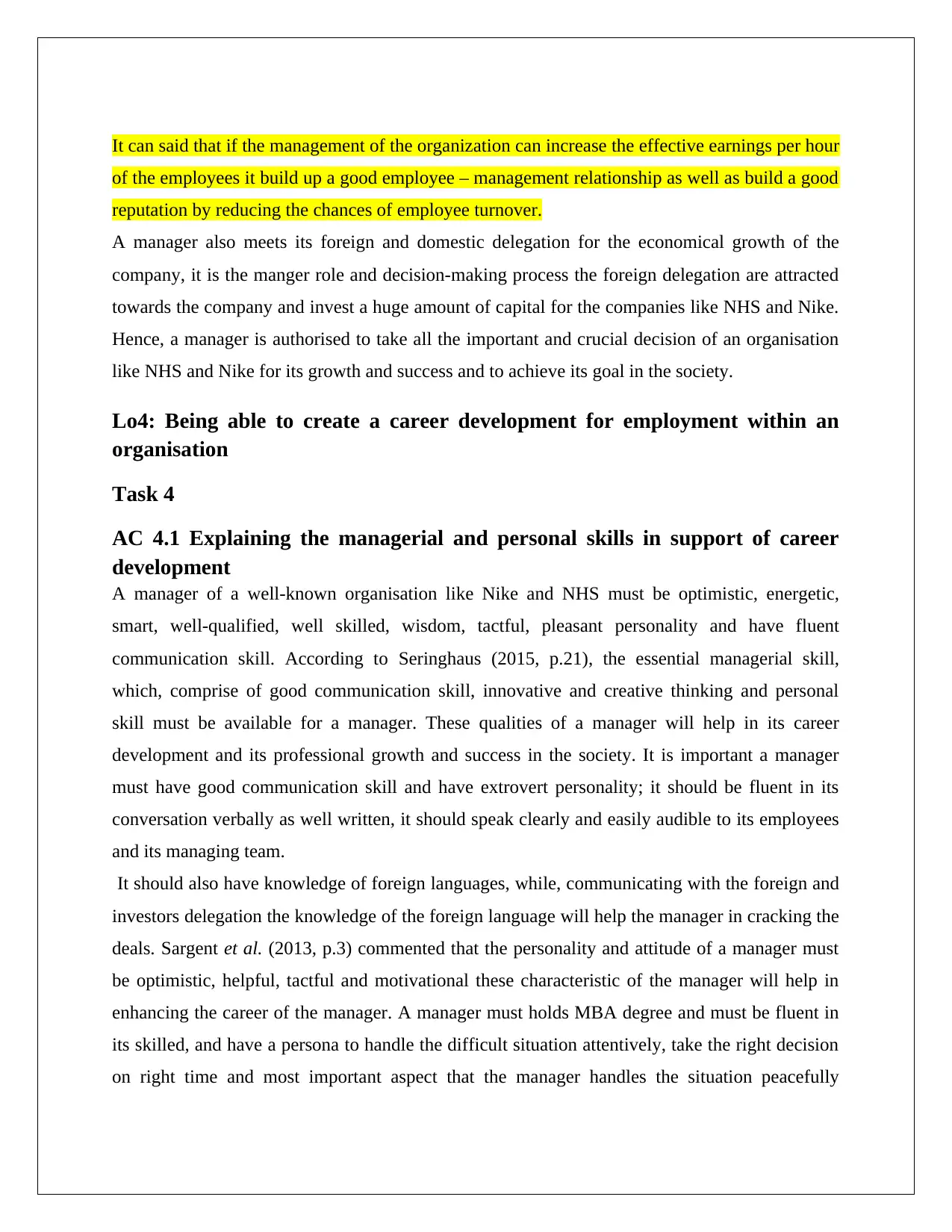
It can said that if the management of the organization can increase the effective earnings per hour
of the employees it build up a good employee – management relationship as well as build a good
reputation by reducing the chances of employee turnover.
A manager also meets its foreign and domestic delegation for the economical growth of the
company, it is the manger role and decision-making process the foreign delegation are attracted
towards the company and invest a huge amount of capital for the companies like NHS and Nike.
Hence, a manager is authorised to take all the important and crucial decision of an organisation
like NHS and Nike for its growth and success and to achieve its goal in the society.
Lo4: Being able to create a career development for employment within an
organisation
Task 4
AC 4.1 Explaining the managerial and personal skills in support of career
development
A manager of a well-known organisation like Nike and NHS must be optimistic, energetic,
smart, well-qualified, well skilled, wisdom, tactful, pleasant personality and have fluent
communication skill. According to Seringhaus (2015, p.21), the essential managerial skill,
which, comprise of good communication skill, innovative and creative thinking and personal
skill must be available for a manager. These qualities of a manager will help in its career
development and its professional growth and success in the society. It is important a manager
must have good communication skill and have extrovert personality; it should be fluent in its
conversation verbally as well written, it should speak clearly and easily audible to its employees
and its managing team.
It should also have knowledge of foreign languages, while, communicating with the foreign and
investors delegation the knowledge of the foreign language will help the manager in cracking the
deals. Sargent et al. (2013, p.3) commented that the personality and attitude of a manager must
be optimistic, helpful, tactful and motivational these characteristic of the manager will help in
enhancing the career of the manager. A manager must holds MBA degree and must be fluent in
its skilled, and have a persona to handle the difficult situation attentively, take the right decision
on right time and most important aspect that the manager handles the situation peacefully
of the employees it build up a good employee – management relationship as well as build a good
reputation by reducing the chances of employee turnover.
A manager also meets its foreign and domestic delegation for the economical growth of the
company, it is the manger role and decision-making process the foreign delegation are attracted
towards the company and invest a huge amount of capital for the companies like NHS and Nike.
Hence, a manager is authorised to take all the important and crucial decision of an organisation
like NHS and Nike for its growth and success and to achieve its goal in the society.
Lo4: Being able to create a career development for employment within an
organisation
Task 4
AC 4.1 Explaining the managerial and personal skills in support of career
development
A manager of a well-known organisation like Nike and NHS must be optimistic, energetic,
smart, well-qualified, well skilled, wisdom, tactful, pleasant personality and have fluent
communication skill. According to Seringhaus (2015, p.21), the essential managerial skill,
which, comprise of good communication skill, innovative and creative thinking and personal
skill must be available for a manager. These qualities of a manager will help in its career
development and its professional growth and success in the society. It is important a manager
must have good communication skill and have extrovert personality; it should be fluent in its
conversation verbally as well written, it should speak clearly and easily audible to its employees
and its managing team.
It should also have knowledge of foreign languages, while, communicating with the foreign and
investors delegation the knowledge of the foreign language will help the manager in cracking the
deals. Sargent et al. (2013, p.3) commented that the personality and attitude of a manager must
be optimistic, helpful, tactful and motivational these characteristic of the manager will help in
enhancing the career of the manager. A manager must holds MBA degree and must be fluent in
its skilled, and have a persona to handle the difficult situation attentively, take the right decision
on right time and most important aspect that the manager handles the situation peacefully
Paraphrase This Document
Need a fresh take? Get an instant paraphrase of this document with our AI Paraphraser
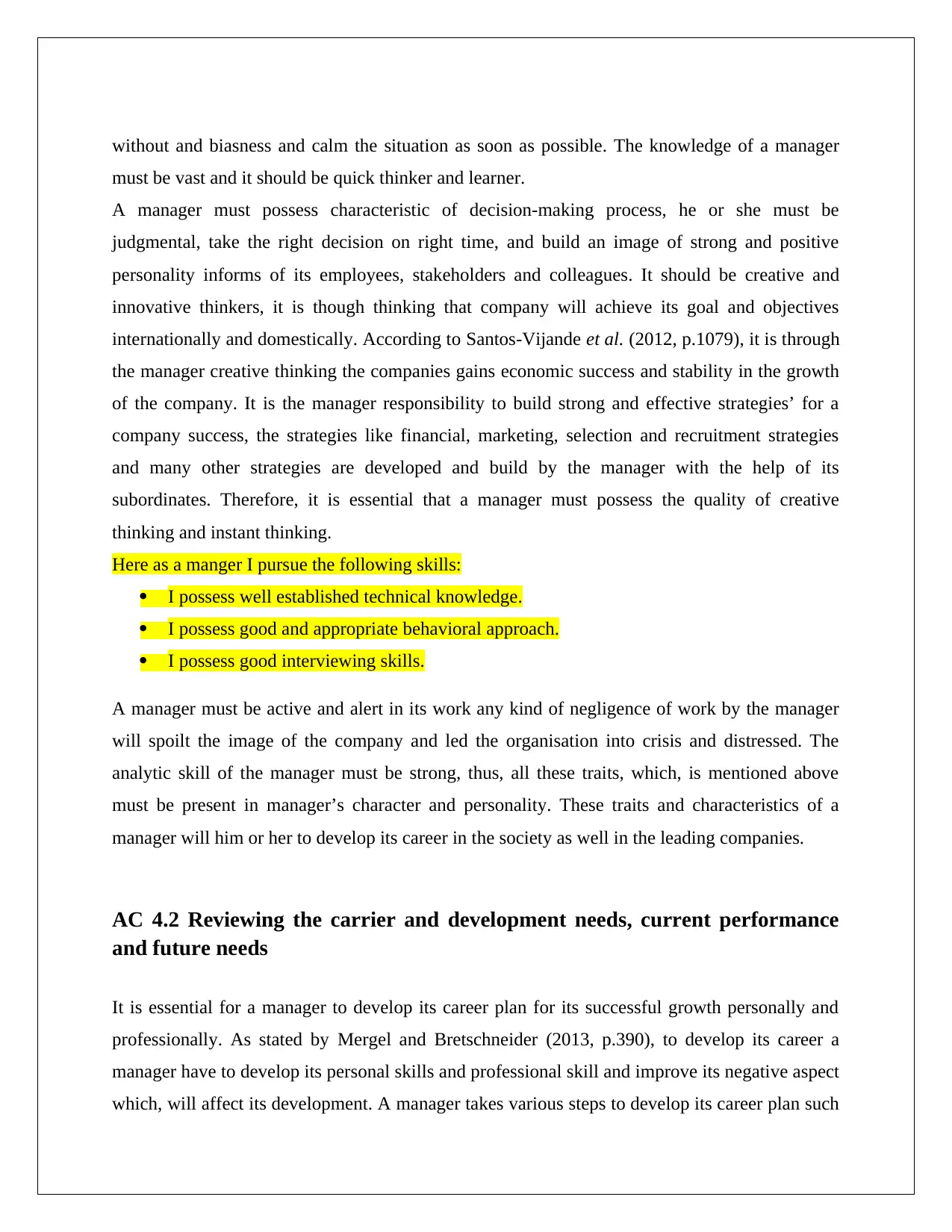
without and biasness and calm the situation as soon as possible. The knowledge of a manager
must be vast and it should be quick thinker and learner.
A manager must possess characteristic of decision-making process, he or she must be
judgmental, take the right decision on right time, and build an image of strong and positive
personality informs of its employees, stakeholders and colleagues. It should be creative and
innovative thinkers, it is though thinking that company will achieve its goal and objectives
internationally and domestically. According to Santos-Vijande et al. (2012, p.1079), it is through
the manager creative thinking the companies gains economic success and stability in the growth
of the company. It is the manager responsibility to build strong and effective strategies’ for a
company success, the strategies like financial, marketing, selection and recruitment strategies
and many other strategies are developed and build by the manager with the help of its
subordinates. Therefore, it is essential that a manager must possess the quality of creative
thinking and instant thinking.
Here as a manger I pursue the following skills:
I possess well established technical knowledge.
I possess good and appropriate behavioral approach.
I possess good interviewing skills.
A manager must be active and alert in its work any kind of negligence of work by the manager
will spoilt the image of the company and led the organisation into crisis and distressed. The
analytic skill of the manager must be strong, thus, all these traits, which, is mentioned above
must be present in manager’s character and personality. These traits and characteristics of a
manager will him or her to develop its career in the society as well in the leading companies.
AC 4.2 Reviewing the carrier and development needs, current performance
and future needs
It is essential for a manager to develop its career plan for its successful growth personally and
professionally. As stated by Mergel and Bretschneider (2013, p.390), to develop its career a
manager have to develop its personal skills and professional skill and improve its negative aspect
which, will affect its development. A manager takes various steps to develop its career plan such
must be vast and it should be quick thinker and learner.
A manager must possess characteristic of decision-making process, he or she must be
judgmental, take the right decision on right time, and build an image of strong and positive
personality informs of its employees, stakeholders and colleagues. It should be creative and
innovative thinkers, it is though thinking that company will achieve its goal and objectives
internationally and domestically. According to Santos-Vijande et al. (2012, p.1079), it is through
the manager creative thinking the companies gains economic success and stability in the growth
of the company. It is the manager responsibility to build strong and effective strategies’ for a
company success, the strategies like financial, marketing, selection and recruitment strategies
and many other strategies are developed and build by the manager with the help of its
subordinates. Therefore, it is essential that a manager must possess the quality of creative
thinking and instant thinking.
Here as a manger I pursue the following skills:
I possess well established technical knowledge.
I possess good and appropriate behavioral approach.
I possess good interviewing skills.
A manager must be active and alert in its work any kind of negligence of work by the manager
will spoilt the image of the company and led the organisation into crisis and distressed. The
analytic skill of the manager must be strong, thus, all these traits, which, is mentioned above
must be present in manager’s character and personality. These traits and characteristics of a
manager will him or her to develop its career in the society as well in the leading companies.
AC 4.2 Reviewing the carrier and development needs, current performance
and future needs
It is essential for a manager to develop its career plan for its successful growth personally and
professionally. As stated by Mergel and Bretschneider (2013, p.390), to develop its career a
manager have to develop its personal skills and professional skill and improve its negative aspect
which, will affect its development. A manager takes various steps to develop its career plan such
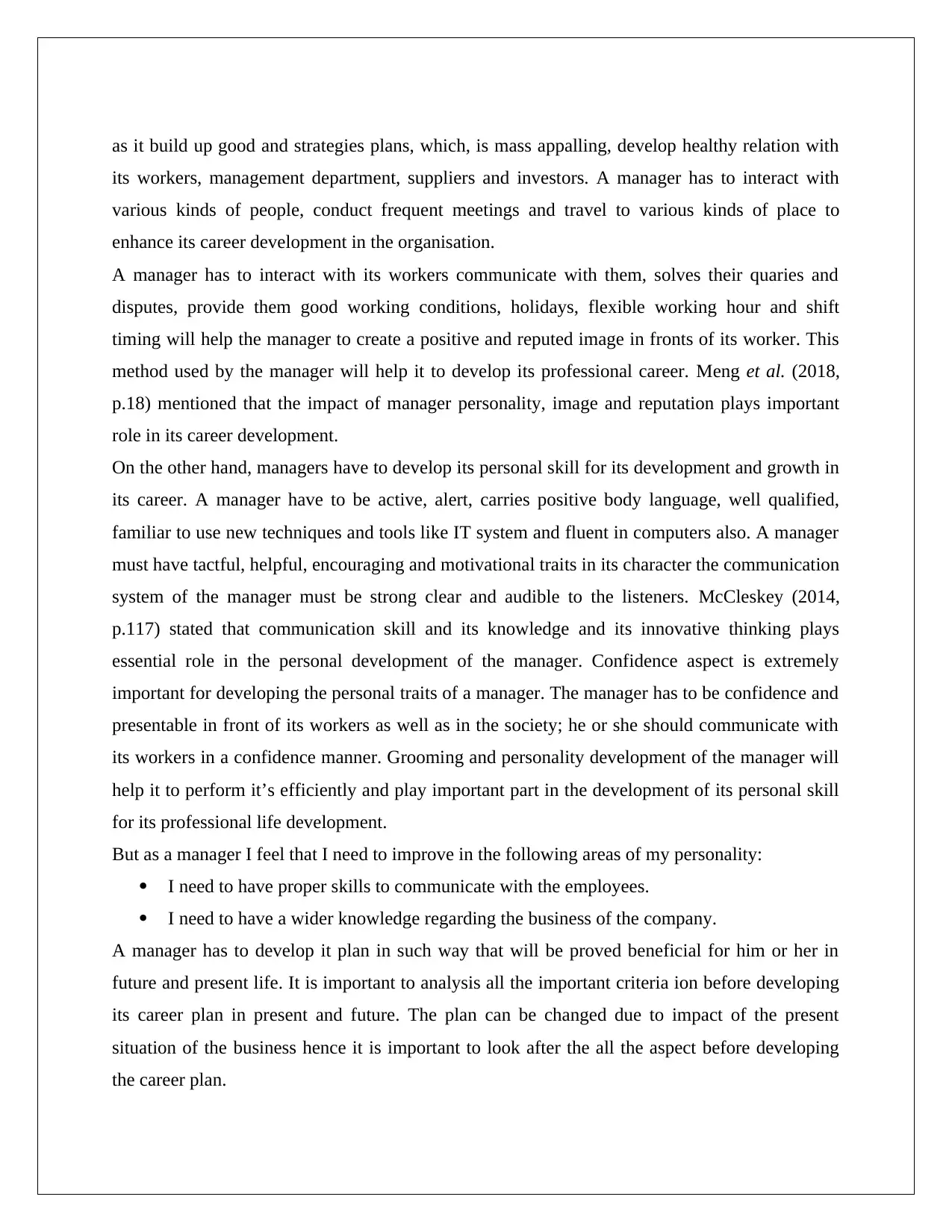
as it build up good and strategies plans, which, is mass appalling, develop healthy relation with
its workers, management department, suppliers and investors. A manager has to interact with
various kinds of people, conduct frequent meetings and travel to various kinds of place to
enhance its career development in the organisation.
A manager has to interact with its workers communicate with them, solves their quaries and
disputes, provide them good working conditions, holidays, flexible working hour and shift
timing will help the manager to create a positive and reputed image in fronts of its worker. This
method used by the manager will help it to develop its professional career. Meng et al. (2018,
p.18) mentioned that the impact of manager personality, image and reputation plays important
role in its career development.
On the other hand, managers have to develop its personal skill for its development and growth in
its career. A manager have to be active, alert, carries positive body language, well qualified,
familiar to use new techniques and tools like IT system and fluent in computers also. A manager
must have tactful, helpful, encouraging and motivational traits in its character the communication
system of the manager must be strong clear and audible to the listeners. McCleskey (2014,
p.117) stated that communication skill and its knowledge and its innovative thinking plays
essential role in the personal development of the manager. Confidence aspect is extremely
important for developing the personal traits of a manager. The manager has to be confidence and
presentable in front of its workers as well as in the society; he or she should communicate with
its workers in a confidence manner. Grooming and personality development of the manager will
help it to perform it’s efficiently and play important part in the development of its personal skill
for its professional life development.
But as a manager I feel that I need to improve in the following areas of my personality:
I need to have proper skills to communicate with the employees.
I need to have a wider knowledge regarding the business of the company.
A manager has to develop it plan in such way that will be proved beneficial for him or her in
future and present life. It is important to analysis all the important criteria ion before developing
its career plan in present and future. The plan can be changed due to impact of the present
situation of the business hence it is important to look after the all the aspect before developing
the career plan.
its workers, management department, suppliers and investors. A manager has to interact with
various kinds of people, conduct frequent meetings and travel to various kinds of place to
enhance its career development in the organisation.
A manager has to interact with its workers communicate with them, solves their quaries and
disputes, provide them good working conditions, holidays, flexible working hour and shift
timing will help the manager to create a positive and reputed image in fronts of its worker. This
method used by the manager will help it to develop its professional career. Meng et al. (2018,
p.18) mentioned that the impact of manager personality, image and reputation plays important
role in its career development.
On the other hand, managers have to develop its personal skill for its development and growth in
its career. A manager have to be active, alert, carries positive body language, well qualified,
familiar to use new techniques and tools like IT system and fluent in computers also. A manager
must have tactful, helpful, encouraging and motivational traits in its character the communication
system of the manager must be strong clear and audible to the listeners. McCleskey (2014,
p.117) stated that communication skill and its knowledge and its innovative thinking plays
essential role in the personal development of the manager. Confidence aspect is extremely
important for developing the personal traits of a manager. The manager has to be confidence and
presentable in front of its workers as well as in the society; he or she should communicate with
its workers in a confidence manner. Grooming and personality development of the manager will
help it to perform it’s efficiently and play important part in the development of its personal skill
for its professional life development.
But as a manager I feel that I need to improve in the following areas of my personality:
I need to have proper skills to communicate with the employees.
I need to have a wider knowledge regarding the business of the company.
A manager has to develop it plan in such way that will be proved beneficial for him or her in
future and present life. It is important to analysis all the important criteria ion before developing
its career plan in present and future. The plan can be changed due to impact of the present
situation of the business hence it is important to look after the all the aspect before developing
the career plan.
⊘ This is a preview!⊘
Do you want full access?
Subscribe today to unlock all pages.

Trusted by 1+ million students worldwide
1 out of 15
Related Documents
Your All-in-One AI-Powered Toolkit for Academic Success.
+13062052269
info@desklib.com
Available 24*7 on WhatsApp / Email
![[object Object]](/_next/static/media/star-bottom.7253800d.svg)
Unlock your academic potential
Copyright © 2020–2025 A2Z Services. All Rights Reserved. Developed and managed by ZUCOL.





